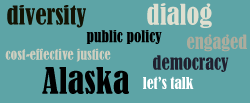A packed crowd gathered at the 49th State
Brewing Company on December 10, 2019 for Alaska Common Ground’s fiscal
forum entitled What kind of Alaska do we want? How
do we get there? The discussion
featured Senator Natasha von Imhof, Co-chair of the Senate Finance Committee;
Anchorage Mayor Ethan Berkowitz; CIRI Government Relations Vice President, Greg
Razo; Institute of Social and Economic Research economist, Mouhcine Guettabi;
and Atwood Chair at the UAA Department of Journalism, Larry Persily. Thea Agnew
Bemben of Agnew::Beck moderated. The goal of the event was to increase public
knowledge and understanding of the realities of Alaska’s financial situation,
and of potential measures to achieve a positive fiscal future.
Senator von Imhof launched the forum with a
well-illustrated dose of reality (see her presentation slides
here). “We are at a
crossroads!” she said. Alaska cannot stay solvent if the state continues to pay
dividends at, or even close to, the current statutory amount. She wants the
legislature to find middle ground for all spending and establish a spending
cap. Though she believes there are still government inefficiencies to be
corrected, she noted that “It takes time and focus and energy to find more
efficiencies…large cuts have to be walked back.”
She and other panelists highlighted the fact that Alaska’s primary
source of revenue for government spending is now through management of the
Permanent Fund as an endowment under Senate Bill 26. State revenue from this
source now exceeds revenue from petroleum production, and, based on current
projections, will continue to do so. The statute established 5.5% as the
percentage of the market value available from the Permanent Fund this year.
Next year it will be 5%. Other endowment systems were studied, and percentages
were carefully gaged and set to protect the principle of the fund.
Greg Razo noted that Alaska’s public
spending must recognize the food insecurity in villages where part of the
economy is subsistence hunting, fishing, and gathering. Climate change is
threatening this ancient and traditional part of Alaska’s economy.
Mayor Berkowitz described how once
generous state assistance to Anchorage has been reduced over the years to a
pittance. Now the state does not even clear sidewalks on state roads within the
municipality. He sees great potential to build the earnings of the Permanent
Fund by investing more money in it. The Mayor advocated dividing the growing
“percent of market value” earnings three ways to establish an ongoing percent
for municipalities, for state services, and for dividends.
Mouhcine Guettabi and Larry Persily
took the lead in emphasizing the economic value of quality of life and the fact
that attracting people and economic development to Alaska depends greatly on
having good state educational systems, transportation, and other public
services. Persily concluded by telling people to look at the math, face
reality, and find the revenues to build the secure and prosperous state that we
want. All speakers noted that establishing ongoing fiscal predictability and
stability would be an economic stimulant. The need for new revenue sources,
such as taxes, was mentioned frequently in describing a positive fiscal future
for our state.
The event was audio recorded by Alaska
Public Media, livestreamed on Facebook, and video recorded by Jenson Hall
Creative. You can watch the video here. Co-chairs of the planning committee for this forum were
Janet McCabe and Cliff Groh. Cliff Groh has written a series of articles for
the Anchorage Press on Alaska’s fiscal issues. You can read one here. If you want to read them all, search for Cliff Groh at anchoragepress.com.

